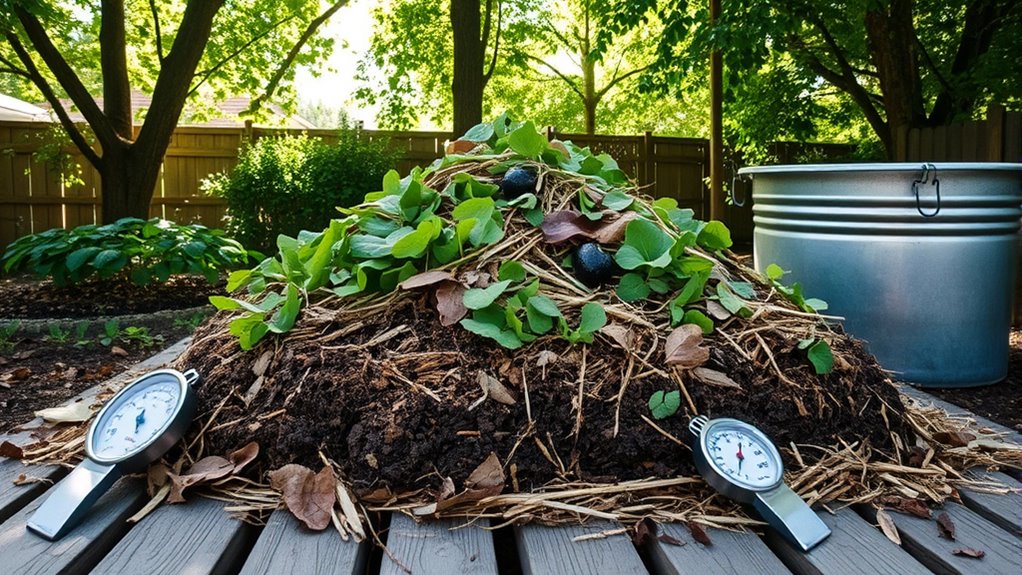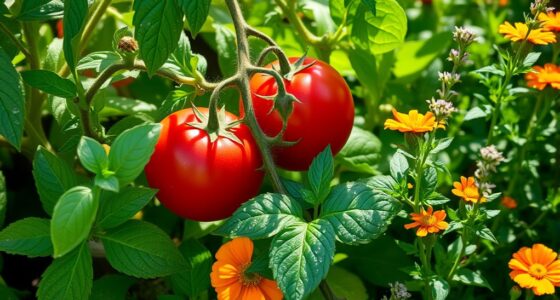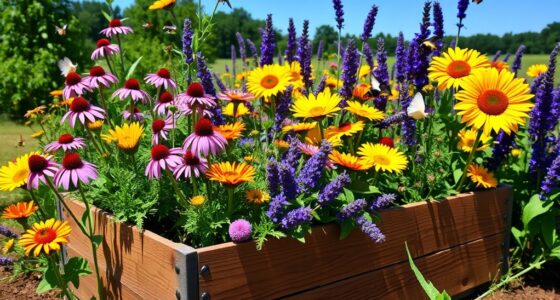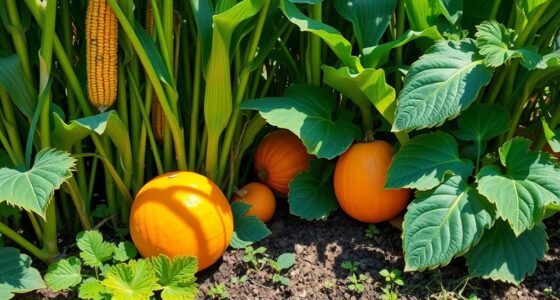To start a compost pile on your homestead, select a sunny, well-drained spot easily accessible for maintenance. Layer browns like dried leaves and straw with greens such as vegetable scraps and grass clippings, keeping a good mix. Keep the pile moist and turn it every few weeks to promote airflow and microbial activity. Monitor the temperature for active decomposition, and once it’s dark, crumbly, and earthy, you can harvest your rich compost. Learn more to master the process.
Key Takeaways
- Choose a well-drained, sunny location with good access for easy maintenance.
- Gather and layer browns (carbon-rich) and greens (nitrogen-rich) for balanced decomposition.
- Keep the pile moist like a wrung-out sponge and turn it regularly to aerate.
- Monitor temperature to ensure active composting, adjusting layers or moisture as needed.
- Harvest mature compost after several months for use in gardens and soil enrichment.

Starting a compost pile is an easy and effective way to turn your kitchen scraps and yard waste into nutrient-rich soil. When you compost properly, you enrich your soil naturally, reducing the need for synthetic fertilizers and supporting healthy plant growth. To get started, you’ll want to gather the right composting tools—items like a compost bin or pile space, a pitchfork or shovel for turning, and a thermometer to monitor temperature. These tools make managing your compost easier and more efficient, ensuring the materials break down quickly and evenly.
First, choose a suitable location for your compost pile. Look for a spot that’s well-drained, receives some sunlight, and is convenient to access. You’ll want to lay down a base of coarse materials like sticks or straw to promote airflow and prevent excess moisture. Layering is key: start with a handful of browns (carbon-rich materials such as dried leaves, straw, or shredded paper), followed by a layer of greens (nitrogen-rich materials like vegetable scraps, grass clippings, or coffee grounds). Repeat these layers, maintaining a balance between browns and greens. This layering not only kickstarts the decomposition process but also improves soil enrichment, turning waste into valuable compost.
Choose a well-drained, sunny spot and layer browns and greens to kickstart composting.
As your compost pile develops, keep it moist but not soaked—think of it like a wrung-out sponge. Using your composting tools, turn the pile every few weeks to aerate it, which accelerates microbial activity and prevents unpleasant odors. If you notice the pile isn’t heating up or decomposing as quickly as you’d like, use the thermometer to track its temperature. A hot compost pile (around 135-160°F) indicates active decomposition and efficient soil enrichment. Adjust your layers or moisture levels as needed.
Patience is essential. Over several months, your pile will transform from a jumble of kitchen scraps and yard waste into dark, crumbly soil. When it looks and smells earthy, you know it’s ready to use. Incorporate this rich compost into your garden beds, around trees, or in your vegetable garden to boost soil fertility naturally. With consistent effort, your composting tools and proper layering will create a sustainable cycle of waste reduction and soil enhancement. By starting a compost pile, you’re not only recycling organic matter but also nurturing your homestead with nutrient-dense soil that supports healthy plant growth and a thriving garden.
Frequently Asked Questions
How Often Should I Turn My Compost Pile?
You should turn your compost pile every 1-2 weeks to maintain proper temperature management and guarantee even decomposition. Regular turning helps aerate the compost, preventing odors and speeding up the process. Place your compost bin in a shaded, well-drained spot to regulate temperature naturally. By turning consistently, you’ll keep the materials balanced, promoting healthy microbial activity and quicker composting, making your homestead more productive.
Can I Compost Meat and Dairy Products?
Think of composting challenges as steering through a maze; meat and dairy can be tricky, but with careful planning, they’re manageable. You can compost these, but they may attract pests and slow down the process. To avoid this, use alternative compost ingredients like vegetable scraps or coffee grounds. If you’re determined, guarantee proper aeration and cover meats and dairy to keep your compost healthy and efficient without compromising your homestead’s sustainability.
What Is the Ideal Moisture Level for Compost?
The ideal moisture level for compost is like a wrung-out sponge, about 40-60% moisture. Proper moisture management guarantees your compost stays hydrated without becoming soggy, which can slow decomposition. You want enough compost hydration to support microbial activity, but avoid excess water that causes odor and compacts the pile. Regularly check moisture levels, add water if it’s too dry, or mix in dry materials if it’s too wet for suitable composting.
How Long Does It Take for Compost to Mature?
It typically takes 3 to 6 months for compost to mature, depending on factors like soil nutrients and compost temperature. You’ll notice the temperature drops and the pile becomes dark and crumbly. Regularly turning it speeds up the process, ensuring proper aeration and microbial activity. When it smells earthy and looks uniform, it’s ready to enrich your soil nutrients, helping your plants thrive.
Can I Use Compost in Potted Plants?
Using compost in potted plants is like giving them a power boost! You can absolutely add your homemade compost to container composting, providing your potted plant nutrients that make them thrive. Just mix it well with soil and avoid overfeeding. Your plants will thank you with vibrant leaves and lush growth, turning your container garden into a paradise of health and beauty. Compost is the secret to stunning potted plants!
Conclusion
Starting your compost pile is simple and rewarding. Imagine planting a vegetable garden next season, using rich, homemade compost you created yourself. Like Sarah, who turned her kitchen scraps and yard waste into fertile soil, you’ll save money and reduce waste. With a little effort, you’ll see your compost thrive, transforming scraps into nutrient-rich soil that boosts your garden’s growth. Get started today and enjoy the benefits of your own sustainable, eco-friendly compost system!









